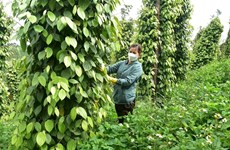Bolstered connectivity needed between trade offices, southern region
It is important to tighten the connectivity between overseas trade offices and southern localities – a growth engine of Vietnam – so as to facilitate export and import activities, an official said.
 Deputy Minister Nguyen Cam Tu (R) and Vice Chairman of the HCM City People’s Committee Le Van Khoa chair the meeting (Photo: VNA)
Deputy Minister Nguyen Cam Tu (R) and Vice Chairman of the HCM City People’s Committee Le Van Khoa chair the meeting (Photo: VNA)HCM City (VNA) – It is important to tighten the connectivity between overseas trade offices and southern localities – a growth engine of Vietnam – so as to facilitate export and import activities, Deputy Minister of Industry and Trade Nguyen Cam Tu has said.
At a trade counsellors’ meeting in Ho Chi Minh City on February 22, representatives from many southern businesses said although the region is home to a large number of enterprises, most of them are of small or medium sizes, partly impeding their market access and competitiveness.
Additionally, they are also unfamiliar with regulations in international trade agreements, participants said.
Phan Minh Thong, Vice Chairman of the Vietnam Pepper Association, pointed out European markets’ food safety rules that pepper companies have to satisfy, asking overseas trade offices to provide domestic firms with detailed information about importing countries’ relevant standards.
Vice Chairman of the HCM City People’s Committee Le Van Khoa said Vietnam’s economy will be unable to integrate into the world if its businesses fail to make integration.
Trade offices should offer concrete assistance to help companies design development strategies in line with international trade commitments to which Vietnam is a party, he added.
Tran Thanh Hai, Deputy Director General of the trade ministry’s Import – Export Agency, said the workload tasked on overseas trade offices will increase amidst intensive regional and global economic integration and growing competition.
He told the offices to liaise more closely with domestic agencies and exert more efforts to expand markets, remove trade barriers and minimise anti-dumping lawsuits.
In 2015, 23 commodities groups posted export turnover of over 1 billion USD each. Up to 79 percent of them were processed and manufactured goods, 12.7 percent were agro-forestry-fishery products, and only 3 percent were minerals.-VNA













